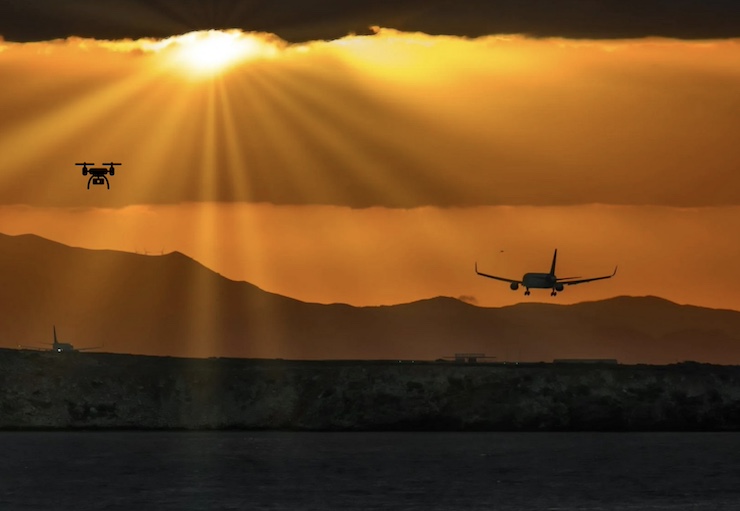
Over the last decade, more and more industries have begun to rely on drone technology. Incorporating drones into logistics, research, construction, agriculture, and more has been the next big step in seeing these enterprises advance into future markets. Though the ways drones are used can vary greatly across the many fields they are now employed in, one main theme unites drone use in all categories: safety. One of the biggest concerns when it comes to drone safety is how to integrate them into shared airspaces. If a drone were to come into the path of a manned aircraft, the results could be disastrous.
In December of 2018, during one of the busiest travel periods, Gatwick Airport near London, England, was closed down because of reported drone sightings. Gatwick Airport, with only one runway, is the second busiest airport in the United Kingdom. After a security officer spotted two drones within the vicinity of the airport, the Civil Aviation Authority (CAA) shut down the runway. Over the course of December 19th, 2018, six more drones were spotted, ultimately leading to hundreds of flights being canceled, 1,000 being rearranged, affecting the travel plans of 140,000 passengers. The incident cost airlines a reported £50m and set a precedent for why it is crucial for drones to be kept out of restricted airspace, such as airports.
While there has yet to be an accident involving a drone and manned aircraft, everyone invested in aviation, manned and unmanned, wants to ensure that the skies are kept safe. In 2022, Innovate UK, a program funding technological development sponsored by governmental, public, and private parties, announced a new program to establish a safe means of incorporating drones into restricted airspace. As explained on Innovate UK’s website, “AgiLe Integrated Airspace System (ALIAS) is an innovative and ambitious project that brings together eight technology companies to demonstrate a scalable and cohesive airspace system for the future. The system will incorporate drones, air taxis, and crewed aircraft operating in unison to deliver economic and societal benefits for the UK.”
The ALIAS project is being tested in the Channel Islands, an ideal location due to its remoteness. Heading the project is Volant Autonomy, based out of Bath, UK. The company was founded in 2018 by three professors from the University of Bath Department of Mechanical Engineering and a former captain and pilot of the British Royal Air Force. The centerpiece of Volant’s technology is called Deterministic Agile Risk Intelligence (DARI). As explained on the company website, “Our certifiable and patent-protected core technology, DARI, allows an unequalled level of risk visibility for the next generation of manned and unmanned aircraft.”
DARI is comprised of three elements geared towards enabling drones to occupy shared airspace. The first is VIA, a program that reduces situational risks by 95% prior to takeoff. The second is TRAJECT, which extends a pilot’s visual awareness from 1 nautical mile to 10 nautical miles. And finally, FLYTE, a redundancy program that provides “safe autonomous flight; using any sensor, to handle any scenario, on any platform for any customer,” as stated on the website. As the ALIAS program approached the end of its two-year timeframe, Volant and their colleagues gathered for a final trial at the Ports of Jersey.
The goal of the final trial was to launch and fly a drone within the same airspace as a manned aircraft. Using Volant’s DARI platform, the trial proved successful. The drone was safely and autonomously flown without any risk to the manned aircraft. Paul Strudwick from the Ports of Jersey pointed out that for now, the test was done at the port, but the success of it will lead to further tests at Jersey Airport, even closer to shared airspace. “We’ve set up this restricted area for these trials to make sure we segregate the commercial aircraft and general aviation from these trials to make it as safe as we can,” Mr. Strudwick said. “The ultimate goal, I believe, from the ALIAS team is that with their technology, we will be able to integrate crewed and uncrewed aircraft in the same airspace.”
As technology continues to advance, initiatives like the ALIAS project represent significant steps towards safely integrating drones into our airspace alongside manned aircraft. With rigorous testing and innovative solutions like Volant Autonomy’s DARI platform, the aviation industry is moving closer to a future where both manned and unmanned aerial vehicles can operate efficiently and securely, fostering new opportunities across various sectors. The success of these trials not only ensures safety in shared airspace but also paves the way for broader adoption of drone technology, promising economic and societal benefits in the years to come.
|